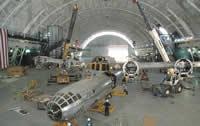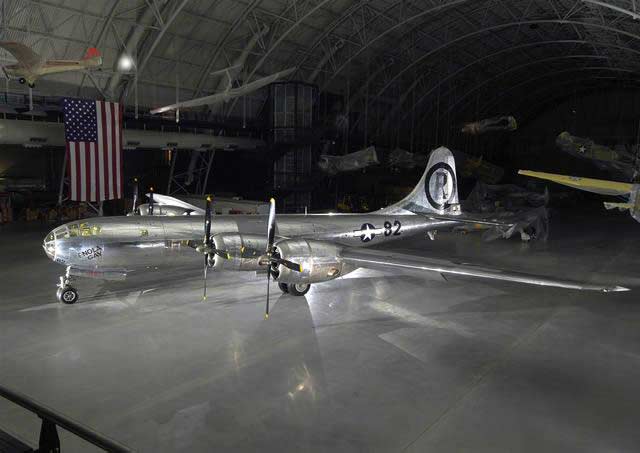 |
 |
 |
 |
Restoration work on the Enola began in 1984 and involved a total of some 300,000 staff hours.
The airplane's forward and aft fuselage sections, wings, landing gear, engines, propellers and vertical stabilizer were brought together for the first time since 1960 in an arduous operation this spring and summer in the Udvar-Hazy (pronounced OOD-var HAH-zee) Center's aviation hangar. The airplane's components had been transported to the center earlier this year over a period of weeks in 12 truckloads from the museum's storage and preservation facility in Suitland, Md.
With a wingspan of 141 feet and a gross weight of 137,500 pounds, the Enola is too large and too heavy to be housed intact in the museum's flagship building on the National Mall in Washington. It will be displayed at the new center raised off the floor on 8-foot-high stands to accommodate other aircraft under its large wings.
The Udvar-Hazy Center, with an aviation hangar 10 stories high and the length of three football fields, allows the museum to display for the first time its largest artifacts. The center will ultimately house the 80 percent of the national collection of aircraft and large space artifacts not on view at the Mall building or on loan.
In presenting the reassembled Enola , museum director Gen. J.R. ?Jack? Dailey said, ?Because of the work of some very talented men and women, future generations will sense first-hand the unalterable significance of this aircraft in World War II and human history. Let's learn from it.?
To bring the airplane back as closely as possible to its wartime condition, museum staff, volunteers and interns removed decades of corrosion from metal surfaces. The airplane's entire outer aluminum skin was painstakingly polished to its original shine. Missing equipment, including radio gear and antenna components, was replaced. Even Boeing logo caps from the period were tracked down for the center of the pilot and co-pilot's control wheels for a complete restoration of the cockpit.
The Enola was built at the Glen L. Martin Aircraft Factory in Omaha, Neb., and accepted by the U.S. Army Air Force as one of 15 ?special mission? B-29s in June 1945. Those aircraft designated for the highly secret 509th Composite Group were outfitted with special engines and propellers and faster-acting pneumatic bomb bay doors. B-29s also represented the first successful large-scale use of pressurized crew compartments.
In June 1945, the Enola participated in several flight training and live bombing practice missions in the Marianas.
On Aug. 6, 1945, the Enola was used to drop, from an altitude of 31,600 feet, the ?Little Boy? atomic weapon, destroying Hiroshima, Japan, at 8:16 a.m. local time. The airplane was flown by Col. Paul Tibbets, commander of the 509th Group, and had a crew of 11. Days before the mission, Tibbets named the airplane ?Enola ? in honor of his mother. The airplane was used as the advance weather reconnaissance aircraft for the atomic bombing of Nagasaki, Japan, on Aug. 9. President Harry Truman announced Japan's surrender on Aug. 14.
After the war, the Enola underwent some modification for tests in the Pacific to determine the effects of atomic weapons on naval ships but it never took part in the program. The airplane returned permanently to the United States in July 1946 and was donated to the Smithsonian Institution on July 3, 1949. Beginning in December 1953, the Enola was stored outdoors at Andrews Air Force Base in Maryland. In August 1960, the airplane was disassembled and its various components were taken to the Smithsonian's nearby storage facility in Suitland.
In June 1995, after much public debate over a proposed large, interpretive exhibition focusing on the Enola and the atomic bomb, the Smithsonian's National Air and Space Museum opened a smaller exhibit that included display of the airplane's forward fuselage and landing gear, vertical stabilizer, two engines and an aileron. The exhibition attracted nearly four million visitors before closing in May 1998.

Photo By Eric Long, NASM
More than 200 aircraft are ultimately destined for the aviation hangar. Smaller aircraft will hang at two levels from the aviation hangar's trusses. Rising walkways will allow visitors to see the suspended aircraft up close and give them a sense of soaring.
Artifact and exhibit-related deliveries to the center continue on an almost daily basis leading up to the December opening when some 80 aircraft will be in place?more than are currently displayed at the Mall building. After the Udvar-Hazy Center opens, deliveries will resume early next year at a slower pace and continue until the facility is full.
The first construction phase of the center also includes the James S. McDonnell Space Hangar, named for the aerospace pioneer and home of the first space shuttle, Enterprise; the 164-foot-tall Donald D. Engen Observation Tower, named for the museum's late director; the Claude Moore Education Center, named for the Virginia philanthropist; an IMAX theater; and a food court.
Thousands of smaller objects from the museum's collection will also be displayed throughout the Udvar-Hazy Center in customized cases, many adjacent to exhibit stations.
No federal funds are being used to build the Udvar-Hazy Center.
The National Air and Space Museum, comprised of the Udvar-Hazy Center and the museum's building on the National Mall, will be the largest air and space museum complex in the world. The flagship building is the most popular museum in the world, attracting more than 9 million visitors each year. Attendance at the Udvar-Hazy Center is projected at 3 million people a year.
The National Air and Space Museum, located at Sixth Street and Independence Avenue S.W., is open seven days a week from 10 a.m. to 5:30 p.m. Admission is free.